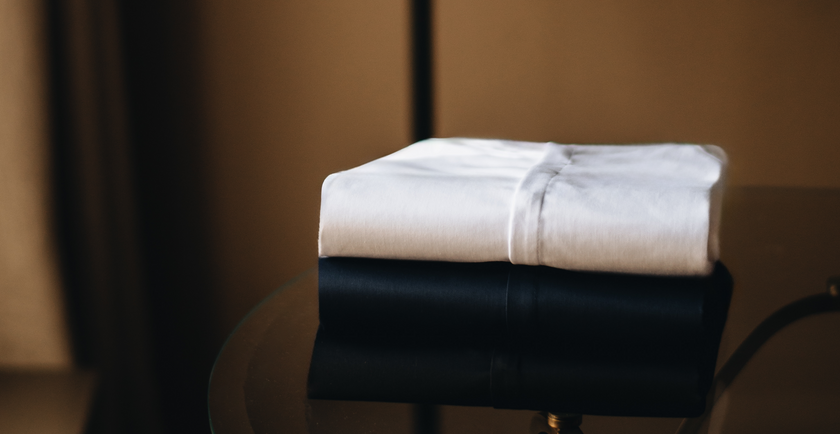Le Nouveau Chef stain care guide
Unexpected stains on your Le Nouveau Chef garments are never welcome. But accidents happen, and most of the time knowledge of simple solutions is the key to solving the stain problem. In this guide, we'll provide tried and tested recommendations for common and stubborn stains you may encounter. The guide provides you with the following stain solutions: Ink, blood, chocolate, coffee, grease, fruit, ketchup, red wine, sweat and deodorant.
Remove ink stains
To remove this inkstain instead of spreading the ink further, start gently blotting the stain instead of rubbing it. Only rub the stain if it doesn't appear to spread. Lemon juice works best for felt pen stains, while ink and permanent markers may require nail polish remover.
Test these solutions on a hidden part of the garment first to ensure colour-fastness. Apply lemon juice to the stain and let it dry. Then, scrub the stain with cold water, using dishwashing liquid, until it disappears. If necessary, use nail polish remover on a cotton pad to completely remove the stain.
Removing blood stains
Immediately rinse the stain with cold water, avoiding hot water that can set the stain. If the stain persists, soak it in cold salt water and gently rub with liquid detergent. For washable garments, follow the care label instructions for normal washing.
For stubborn blood stains, make a paste using baking soda, cornstarch, or talcum powder mixed with cold water. Apply the paste to the stain and let it sit before washing according to the care label. Alternatively, for light-coloured clothes, squeeze half a lemon over the stain, sprinkle salt, and gently remove the mixture with a damp cloth.
Removing chocolate stains
Carefully scrape off excess chocolate from the fabric. Flush the stained area with cold running water, rub liquid washing detergent or dishwashing liquid into the stain. Soak the garment in cold water, gently rubbing the stain until it disappears. Wash the garment as usual, following the care label instructions. If the stain persists, apply a stain remover before washing. Be cautious with stain removers containing bleach on darker garments.
Removing coffee stains
Immediately rinse the coffee stain with cold water, aiming to lift the stain from the fabric. If the stain remains, work in liquid laundry detergent and let it sit for a few minutes. Repeat as necessary. Once the stain is no longer visible, wash the garment as usual following the care label instructions.
Removing grease stains
Start by using regular dishwashing liquid and gently rub it into the stain. Rinse the stained area with hot water and repeat the process if the stain persists.
Some stains may require a stain remover along with dishwashing liquid or liquid wash detergent. If you have coloured garments, ensure you use a colour-safe, non-chlorine/bleach-free stain remover. Work the stain remover into the stain and let it sit for about 10 minutes. Without rinsing, add dishwashing liquid or liquid wash detergent to the stain remover already on the stain. Let it sit for another 10 minutes.
Follow the care label instructions for washing. Avoid steaming or ironing the garment if the stain hasn't been completely removed, as this can set the stain and make it harder to remove.
Removing fruit and berry stains
Act quickly and use a spoon to scrape off as much of the fruit or berry as possible from the fabric's surface. Soak the stain in cold water. If the garment is washable, flush the stain from the inside out to push the stain out of the fibres. Make sure to use cold water. Apply some stain remover or liquid detergent to the stain and gently work it into the fabric using circular motions with a small brush. For coloured garments, opt for a colour-safe, non-chlorine/bleach-free stain remover. If you don't have liquid wash detergent or stain remover, dishwashing liquid works just fine. Once the stain is no longer visible, either dry the garment or wash it as usual in the machine.
Removing ketchup stains
Act swiftly and use a spoon to scrape off as much of the sauce as possible from the fabric's surface. Soak the stain in cold water. Again, ensure the water is cold. Apply stain remover or liquid detergent to the stain and gently work it into the fabric using circular motions with a small brush. For coloured garments, choose a colour-safe, non-chlorine/bleach-free stain remover. Sometimes, soaking the garment in cold water and then rubbing dish detergent on the stain may suffice.
Removing red wine stains
Act quickly and blot up as much excess wine as possible using a towel or cloth. Avoid rubbing the stain; simply press the cloth against the spot to absorb the wine.
Sprinkle salt onto the stain and gently press it. The salt will absorb the wine and help lift the stain. After a while, brush away the salt. If the stain is still noticeable, saturate it with cold water and repeat the salt process.
When it's time to wash the garment, preferably as soon as possible after the stain occurs, treat the spot with a stain remover and launder the garment as usual. For coloured garments, opt for a colour-safe, non-chlorine/bleach-free stain remover.
For old wine stains: With a bit of luck, you can still eliminate old, deep-set wine stains. Simply be patient. Start by rubbing liquid detergent on the stain. Then soak the garment in cold water for one hour before applying a stain remover and washing it on a normal cycle.
Removing sweat and deodorant stains
Yellow sweat stains in the armpits of white shirts are frustratingly common. The yellow stains occur when deodorant with aluminium-based ingredients reacts with your body's natural oils. Sometimes, using certain laundry detergents can worsen the stains. It's important to examine the stain to determine the most effective removal method.
If the stain is white, hard, and/or brittle, a stain remover will likely be your saviour. Rinse it under cold water for a while, then gently treat it with a stain remover and launder it as usual. For coloured garments, choose a colour-safe,
non-chlorine/bleach-free stain remover.
Yellow stains can be tough to remove. A trick is to create a solvent by mixing three parts baking soda with one part water. Let the solvent work on the stain for up to one hour, then rinse the garment or wash it as usual. You may need to repeat this process for optimal results.
We hope these stain removal tips have been helpful in extending the lifespan of your Le Nouveau Chef garments. By following these techniques and using quality stain removers, you can protect your valuable chef wear and catering uniforms, ensuring they remain durable and stain-free. Remember to always check the care label washing instructions for your specific garments first and use responsible stain removal methods to maintain their quality.




